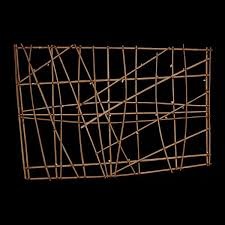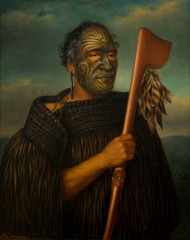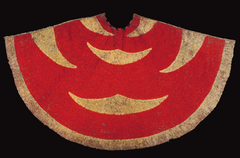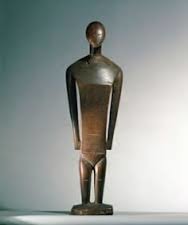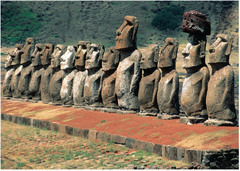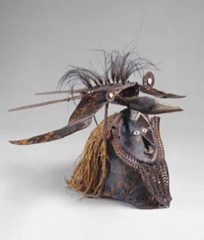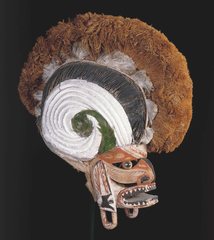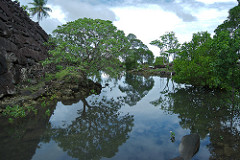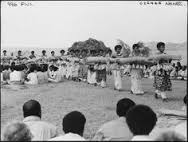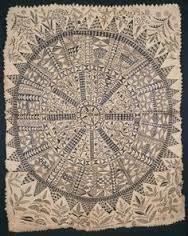Navigation chart. Marshall Islands, Micronesia. 19th to early 20th century C.E. Wood and fiber.
N: Navigation Chart
D: 19th century
date collected: 1890-1893 collected
P: micronesia and were used by the Marshallese
A: Marshall Islands Inhabitants
Pa: unknown
OL: Marshall Islands
M: vertical and horizontal and diagonal wooden sticks, cowrie and small shells, and coconut and fibers
T: Rebbelib, a type of navigation chart used to cover a large section of the Marshall Islands.
F: It shows the main pathway between the two main islands, the intersecting lines or areas marked by shells indicate locations of islands while the slopped lines indicate wave swells and the people using them usually memorized them.
C: The Marshall Islands in eastern Micronesia consist of thirty-four coral atolls spread out across an area of several hundred miles. In order to maintain links between the islands, the Marshall Islanders built seafaring canoes. These vessels were both quick and maneuverable. The islanders developed a reputation for navigation between the islands - not a simple matter, since they are all so low that none can be seen from more than a few miles away. charts marked the location of the islands and swell along with the wave patterns. cowries and shells= islands. straight lines=currents are consistent. bent lines= wind and swells. coconut fibers= wave patterns.
DT: slopped lines that indicate wave swell show technological advancement in society, intricate weaving
M: to direct the natives to islands nearby safely and quickly for trade, by predicting wave swells and the exact locations of islands. mattang specifically made for training people who are selected to be navigators.
Tamati Waka Nene. Gottfried Lindauer. 1890 C.E. Oil on canvas.
N: Tamati Waka Nene
D: 19th to early 20th century C.E.
P/S: Realism
A: Gottfried Lindafvv
Pa: In Lindauer's notebook this portrait is numbered #6 with an inscription saying 'for Mr Partridge'
OL: Ngāti Hao, Ngāpuhi
M: Oil on Canvas
T: Lindauer based this portrait on a photograph by John Crombie who was commissioned to produce 12 photographic portraits of Māori chiefs for the London Illustrated News
F: To commemorate the Maorian chief, Tamati Waka Nene, on being the first of the Pacific islands to join the International trade with England.
C: Tamati Waka Nene lived in the Hokianga when it was a thriving and prosperous trading society and was said to have been an astute businessman and kindly by nature. He was the 2nd son of Tapua, leader and tohunga of Ngati Hao of Hokianga. Nene converted to the Wesleyan faith and was baptised taking his name Tamati Waka Nene after Thomas Walker. Nene saw the advantages of having Pākehā shipping traders in the area, and helped settlers as well as Wesleyan missionaries establish themselves there in 1827. Nene is wearing a tattoo mask which shower power and protection. Tattooing is called moko. The tattoo was a mark of adultment and helped soften the bone structure. Nene died on August 4, 1871.
DT: smooth brushstrokes, painted to show kind nature of the chief, compassionate, similar portrait style to the Mona Lisa, painted with tribal face paint to reinforce culture
M: to show the Westerners appreciation for the Pacific islanders and their contribution to trading
'Ahu 'ula (feather cape). Hawaiian. Late 18th century C.E. Feathers and fiber.
N: 'Ahu 'ula
D: late 8th century C.E.; polynesia
M: feathers and fibers; made of 500,00 feathers and each bird only gives off 7 feathers; 'i'iwi bird=red feathers; 'o'o bird= yellow and black feathers
S: semi-circular cape is considered a later development of the trapezoidal shape
T: intensive labor it takes to make this; made by attaching thousands of small bundles of feathers to a base netting, made in straight rows with pieces and were cut to form the desired shape; then tiny bundles of feathers were attached to the netting in overlapping rows starting at the lower edge
F: worn as a cape and it is supposed to protect one's mana (preventing people and spirits from reaching you); ceremonial and used in battle; part of aristocratic culture
C: they were used to assert chiefly power and maintain social control; its unique to Hawaiian culture; they traded 36 cloaks and brought them to England but they only saw them as exotic and weird instead of beautiful; people told stories about these cloaks being used or going through a battle; this was found on Captain Cook's last faithful voyage; men would wear these cloaks or capes
M: the capes were symbols of power and social standing in Hawaii; the red=gods and chiefs; yellow=gods and chiefs; asserts chiefly power; showed respect and it was given to people who had power; believed that Humans were offspring of God
Staff god. Rarotonga, Cook Islands, central Polynesia. Late 18th to early 19th century C.E. Wood, tapa, fiber, and feathers.
N: Staff God; "atua rakau"
D: late 18th century to early 19th century; polynesia
A: Unknown
P: Unknown
OL: Rarotonga, Cook Islands, Central Polynesia
M: barkcloth, ironwood, Tapa, Fiber, and feathers; composed of a central wood shaft wrapped in an enormous roll of decorated bark cloth
S: distinctive style; genoolgraphic
T: The carver may have depicted smaller people below the deities to make it seem that they are coming out of him or that he is creating them. This particular staff did not include feathers however, others were believed to have them on the back staff areas.
F: Religious ceremonies (possibly a fisherman's God). It was small in size for the ability to travel with the owner; sacred; religious
C: They were used in worship to their deities, at the beginning of the 19th century Polynesians converted to Christianity suddenly and they were forced to destroy similar wood carvings, very few survived; deity images w/ multiple figures attached to their bodies which are characteristic of Rurutu in the Astral Islands and of Rarotonga and Mangaia in the Cook Islands; lower end is a carved phallus; Reverend John Williams observed and found that the bark cloth contained red feathers and pieces of pearl shell which is known as the spirit of the god; this was a gift from the New Zealand government; it has a carved upper section; large smooth head, curved neck that has notches; there are 5 small figures on the staff which contains people and turtles; it has male and female reproductive qualities; they combine the results of labor skilled men and women; staff god: 60 cm x 20 cm
M:they represent the islands; they represent the historical figure Tigora of descent being passed down; has male and female atributes: creator god; they represent Tangaroa (creator god); carvings represented the clan and district ancestors who were honored for their protective and procreative powers; the images refer to the creator deities of the Polynesians and they were revere for their central role in human fertility
DT: Detail oriented
Female deity. Nukuoro, Micronesia. c. 18th to 19th century C.E. Wood.
N: Female Deity
D: 18th to 19th century P/S: Pacific Art
A: unknown
PA: unknown
OL: Nukuoro, Micronesia
M: breadfruit tree (wood)
T: Carving, these figurines were of smaller statrue and most likey required experice to achieve lines on the Deity.
F: The figurine is known to have been used in religious cerimonies. However the specific type of cerimony is unknown. Some speculation suggest they may have been used in fertility ceremonies. placed in temples and decorated with loom-woven bands, fine mats, feathers, paint, or headdresses. its supposed to guide the spirits; "guardian angel" statue.
C: Only 20 left in the world. The Female Deity is shown with many protruding areas from the elbows, shoulders, and breasts. It could be argued that they focused on the functino over the form. Keeping the visual effects simple; has a columnar neck; shoulders sloped down and chest indicated by a line; each figurine had the name of a specific male or female deity associated with a particular extended family group; during this ceremony, the harvested fruits and food were offered and brought to these sculptures; they were considered a resting place for god or a deified ancestral spirit; this specific figurine depicts the goddess of the sewake clan; it's 7 feet tall; she has a tattoo on her private area; feet are too decayed; stylized pierced ears and chin but no other facial features
DT: Protudring areas, simple, stiff, rigid
M: represents a strong force in social life; death and memory
height 220 cm (7 ft)
Moai on platform (ahu). Rapa Nui (Easter Island). c. 1100-1600 C.E. Volcanic tuff figures on basalt base.
N: Moai on platform
D: 1100-1600 C.E.
OL: Rapa Nui, Easter Island
M: made of basalt
T: carved from pics
P: polynesia
S: monolith; statues
C: one of the earliest datable artworks in oceania and are also the largest; monumental sculptures; 50 ft tall and weighs 4 tons; most of the moai of huge blocky figures with fairly planar facial features: large staring eyes, strong jaw, straight nose with carefully articulated nostrils and elongated ear lobes; a number of moai have pukao (small red scoriac, a local volcanic stone cylinders that serve as a sort of top knot or hat); moarian platform; backs are facing the sea; 900 statues are still there
F: carved to commemorate ancestors; the backs are facing the sea so that they could keep watch over the island; represents power; many scholars believe lineage chiefs of their sons erected the moai and sculptures depict ancestral chiefs; Easter Islanders believed they had the ability to accommodate spirits or gods; statues mediate between chiefs and gods along with between the natural and cosmic worlds; burial; sacred
Buk (mask). Torres Strait. Mid- to late 19th century C.E. Turtle shell, wood, fiber, feathers, and shell.
N: Buk (mask)
D: Mid to Late 19th century
P/S: N/A
A: Torres Strait Islander people
Pa: Elders of the Torres strait society
OL: Mabuiag Island, Torres Strait, Australia
M: Turtle shell, wood, fiber, frigate bird feathers, shell
T: hand-crafted and unique to ceremony
F: Turtle-shell masks in the western Torres Strait reportedly were used during funerary ceremonies and increase rites (rituals designed to ensure bountiful harvests and an abundance of fish and game). ritual; this is worn over the head like a mask; used for male initiation; funerary rights
C: The ceremonies often involved performances in which senior men, wearing the masks together with rustling costumes of grass, reenacted events from the lives of culture-heroes, drawn from local oral tradition. Divided into 3 registers: bottom (human face), middle (body of a bird), top (feathers); face has a raffia attached to it= hair; part of an elaborate costume used in a masquerade and people would dance wearing the mask; bird can be seen as a totem; width=25 in; mask made from turtle shell;
DT: Rough, made of native materials, resembles totem pole
M: This work displays the composite human and animal imagery typical of western Torres Strait masks, and provides insight on the beliefs/religion of the islanders at the time.; depicts a human face portraying a culture hero; surmounted by frigate bird representing his personal totemic species;
Malagan display and mask. New Ireland Province, Papua New Guinea. c. 20th century C.E. Wood, pigment, fiber, and shell.
N: Malagan display and mask
D: c. 20th Century C.E.
T: hand painted
P/S: Tribal Art/ Ceremonial Art
A: Unknown
Pa: None
OL: New Ireland Province, Papua New Guinea
M: Wood, Pigment, Fiber, and Shell T: Weaving, Figure-making, free-hand painting
F: To serve as visual part of ceremony in which the dead are celebrated and assisted in their transition to the spiritual realm, the ceremonies length can be from months to years so sturdy materials for elaborate structures can withstand long time frame; centered on honoring the dead
C: The culture behind the Malagan display and mask greatly treasure ancestry and the soul/life force of an individual which is what is often portrayed in these displays. They also believe that their loved ones spirits enter into the Malagan so these pieces are treated with the upmost care until they are no longer needed. Once they are no longer needed they are often burned in fear of confusing other spirits trying to find their way. New Ireland has 19 islets. the ceremonies held can last from months to years. once the soul leaves the mask they burn it. it had both men and women genitalia.
DT: Natural, mystical, elaborate, large, complex, interwoven, cohesive.
M: These pieces serve to represent the deceased's souls in our world and the ceremonies help to push them on to the spirit world. Also because of the cultures sense of community and familial values we also see it as a way for the entire village to mourn and to publically display the death of a family member. The Malagan, lastly, are very substantial in displaying class because more powerful people were made grander structures and masks. the ceremonies that are held sent the souls of the deceased to the dead. they are intended to represent individual's souls.
Nan Madol. Pohnpei, Micronesia. Saudeleur Dynasty. c. 700-1600 C.E. Basalt boulders and prismatic columns.
N: Nan Madol
D: 700-1600 C.E.
T: man-made; islets were constructed by placing large rocks and fill a top submerged coral reefs to form raised platforms supporting elaborate residential and ceremonial complexes
M: complexes were built from columnar basalt, a volcanic rock that breaks away naturally to form massive rodlike blocks that make an ideal building material; prismatic structures
F: center of religion; mortuary; ritual; ceremonial for the ruling chiefs of the saudeleur dynasty; break walls for canals; protect the city from the ocean; administrative and ceremonial center
C: highly stratified social system; home to thousands; earliest known place for such centralized political power in the western pacific; the larger homes are made for the chiefs showing the social hierarchy; there are shallow lagoons; there are walls to protect from the ocean; 92 artificial islands covering covering 170 acres; sea walls are 17 ft high and 35 ft wide; break walls are for the canals; they are reflective of the king; islands are arranged for the winds; had a cubical tomb
Processional welcoming Queen Elizabeth II to Tonga with Ngatu launima (tapa cloth). Tonga, central Polynesia. 1953 C.E. Multimedia performance (costume; cosmetics, including scent; chant; movement; and pandanus fiber/hibiscus fiber mats), photographic documentation.
N: Processional Welcoming Queen Elizabeth II to Tonga with Ngatu launima (tapa cloth)
D: 1953 C.E. P/S: Modern Art/ Video Art
A: Unknown
Pa: None
OL: Tonga, Central Polynesia
M: Multimedia performance (costume; cosmetics, including scent; chant; movement; and pandanus fiber/ hibiscus fiber mats), photographic documentation. made ngatu with bark cloth.
T: Photography, documentation.
F: To show respect and gratitude towards Queen Elizabeth II for visiting Tonga and for commemorating the war memorial. Also I believe this served as a way of the two countries signaling their alliance and partnership. idol and spiritual. used for funerals. banner sometimes used to decorate graves. queen visited in 1953. the ngatu was placed under the body of the queen.
C: During both world wars the people of Tonga and England have fought for same cause and have even assisted each other at times so in order to so union between two countries English royal family visits Tonga for the first time and honors those who died in the line of duty. made bark cloth for queens (it had hand painted decoration on cloth)
DT: Elaborate, native, unique, representative, grand-scale, natural
M: The meaning behind the display involves along lasting peace agreement between both queens and Queen Elizabeth's desire to thank those who served, fought, and died in World War II, is what inspirers her arrival. Because it was the first time any English Queen had stepped foot onto the island so it is a celebration of many years of peace and common cause in the war efforts.
Hiapo (tapa). Niue. c. 1850-1900 C.E. Tapa or bark cloth, freehand painting.
N: Hiapo (tapa)
D: 1850-1900 C.E.
P/S: Pacific Art
A: Unknown
P: polynesia
OL: unknown (somewhere in the Pacific islands)
M: Tapa or bark cloth
S: distinctive and iconography
T: Freehand painting on the cloth. The tribe's people would beat the cloth after weaving to strengthen bonds.
F: The Pacific Islanders were known for wrapping their sacred items in tapa cloths which was unique to their culture. The clothes varied in size and what they protected. used for clothing, bedding, or wall hangings.
C: In the Islander culture the women's jobs were to weave and beat the Tapa clothes for use. earliest examples of hiapo were collected by missionaries. contains geometric and complex designs. the patterns have spirals, circles, squares, triangles, and diminishing motifs (they decrease in size from the border to the center).
DT: geometric organization, intricate patterning
M: There is very few remaining authentic Tapa clothes, although they were meant to protect sacred items because few remain they in themselves have become sacred. introducing depictions of human figures into their bark cloth. connection to people who made it made by a community.
